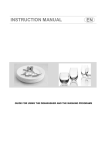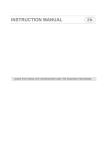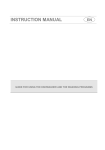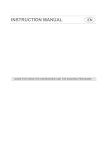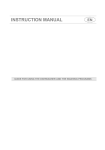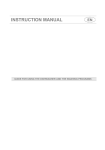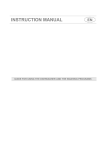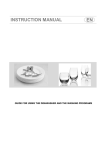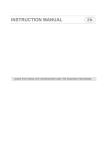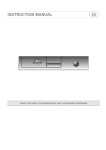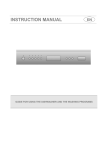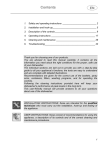Download Smeg D4B-1 dishwasher
Transcript
INSTRUCTION MANUAL GUIDE FOR USING THE DISHWASHER AND THE WASHING PROGRAMS Contents 1. 2. 3. 4. 5. 6. Safety and operating instructions ___________________________ 2 Installation and hook-up __________________________________ 5 Description of the controls _______________________________ 10 Operating instructions ___________________________________ 22 Cleaning and maintenance _______________________________ 34 Troubleshooting _______________________________________ 39 Thank you for choosing one of our products. You are advised to read this manual carefully; it contains all the information you need about the right conditions for the proper, safe use of your dishwasher. The individual sections are laid out to provide you with a step-by-step guide to all your appliance's functions; the texts are easy to understand and are complete with detailed illustrations. Recommendations are given for the correct use of the baskets, spray arms, containers, filters, washing programs, and for operating the controls. Following the cleaning instructions provided here will keep your dishwasher's performance at peak levels in the long term. This user-friendly manual will provide answers to all your questions about use of the dishwasher. INSTALLATION INSTRUCTIONS: these are intended for the qualified technician who must carry out the installation, hook-up and testing of the appliance. USER INSTRUCTIONS: these consist of recommendations for using the appliance, a description of its controls and of the correct cleaning and maintenance procedures. 1 Safety instructions 1. Safety and operating instructions THIS MANUAL FORMS AN INTEGRAL PART OF THE APPLIANCE: IT MUST ALWAYS BE KEPT INTACT TOGETHER WITH THE DISHWASHER. BEFORE USING THE APPLIANCE, CAREFULLY READ ALL THE INSTRUCTIONS CONTAINED IN THIS MANUAL. INSTALLATION MUST BE PERFORMED BY A QUALIFIED TECHNICIAN, IN COMPLIANCE WITH THE REGULATIONS IN FORCE. THIS APPLIANCE IS INTENDED FOR DOMESTIC USE AND SIMILAR APPLICATIONS SUCH AS THE STAFF KITCHENS OF SHOPS, OFFICES AND OTHER WORKPLACES, INSTITUTIONS, AND FOR THE USE OF GUESTS AT HOTELS, HOSTELS, BED AND BREAKFAST ESTABLISHMENTS AND OTHER RESIDENTIAL FACILITIES AND COMPLIES WITH DIRECTIVES 2006/95/EC AND 2004/108/EC CURRENTLY IN FORCE, INCLUDING THE PREVENTION AND ELIMINATION OF RADIO FREQUENCY INTERFERENCE. THE APPLIANCE IS DESIGNED FOR THE FOLLOWING PURPOSE: WASHING AND DRYING OF DISHES; ANY OTHER USE SHALL BE CONSIDERED IMPROPER. THE MANUFACTURER DECLINES ALL RESPONSIBILITY FOR USES OTHER THAN THOSE DESCRIBED ABOVE. THE NAME PLATE FEATURING THE TECHNICAL DATA, SERIAL NUMBER AND MARKINGS IS VISIBLY POSITIONED ON THE INNER EDGE OF THE DOOR. THE NAME PLATE ON THE INNER EDGE OF THE DOOR MUST NEVER BE REMOVED. DO NOT LEAVE THE DISCARDED PACKAGING MATERIALS UNSUPERVISED WITHIN THE HOME. SEPARATE THE VARIOUS MATERIALS WHICH MAKE UP THE PACKAGING AND TAKE THEM TO THE NEAREST SORTED WASTE COLLECTION CENTRE. THE APPLIANCE MUST BE PROVIDED WITH AN EARTH CONNECTION IN ACCORDANCE WITH THE ELECTRICAL SAFETY REGULATIONS IN FORCE. THE MANUFACTURER DECLINES ALL RESPONSIBILITY FOR DAMAGE TO PERSONS OR PROPERTY RESULTING FROM THE FAILURE TO EARTH THE APPLIANCE OR FROM A DEFECTIVE EARTH CONNECTION. IF THE APPLIANCE IS INSTALLED ON A CARPETED OR COVERED FLOOR, ENSURE THAT THE OPENINGS ON ITS UNDERSIDE ARE NOT OBSTRUCTED. ALWAYS SWITCH OFF THE DISHWASHER AFTER EACH USE TO AVOID WASTING ELECTRICITY. IN THE EVENT OF A FAULT, DISCONNECT THE DISHWASHER FROM THE ELECTRICAL POWER SUPPLY AND SHUT OFF THE WATER TAP. DO NOT USE STEAM CLEANERS TO CLEAN THE DISHWASHER. 2 Contents WARNING: SOME DISHWASHER DETERGENTS ARE STRONGLY ALKALINE. THEY CAN BE EXTREMELY DANGEROUS IF SWALLOWED. AVOID CONTACT WITH THE SKIN AND EYES AND KEEP CHILDREN AWAY FROM THE DISHWASHER WHEN THE DOOR IS OPEN. CHECK THAT THE DETERGENT RECEPTACLE IS EMPTY AFTER COMPLETION OF THE WASH CYCLE. OBSOLETE APPLIANCES MUST BE RENDERED UNUSABLE. CUT OFF THE MAINS POWER CORD AFTER UNPLUGGING IT FROM THE WALL OUTLET, AND MAKE SAFE ANY COMPONENTS WHICH MIGHT BE DANGEROUS FOR CHILDREN (LOCKS, DOORS, ETC.). THIS APPLIANCE IS MARKED ACCORDING TO THE EUROPEAN DIRECTIVE 2002/96/EC ON WASTE ELECTRICAL AND ELECTRONIC EQUIPMENT (WEEE). BY ENSURING THIS PRODUCT IS DISPOSED OF CORRECTLY, YOU WILL HELP PREVENT POTENTIAL NEGATIVE CONSEQUENCES FOR THE ENVIRONMENT AND HUMAN HEALTH, WHICH COULD OTHERWISE BE CAUSED BY INAPPROPRIATE WASTE HANDLING OF THIS PRODUCT. THE SYMBOL ON THE PRODUCT, OR ON THE DOCUMENTS ACCOMPANYING THE PRODUCT, INDICATES THAT THIS APPLIANCE MAY NOT BE TREATED AS HOUSEHOLD WASTE. INSTEAD IT SHALL BE HANDED OVER TO THE APPLICABLE COLLECTION POINT FOR THE RECYCLING OF ELECTRICAL AND ELECTRONIC EQUIPMENT. DISPOSAL MUST BE CARRIED OUT IN ACCORDANCE WITH LOCAL ENVIRONMENTAL REGULATIONS FOR WASTE DISPOSAL. FOR MORE DETAILED INFORMATION ABOUT TREATMENT, RECOVERY AND RECYCLING OF THIS PRODUCT, PLEASE CONTACT YOUR LOCAL CITY OFFICE, YOUR HOUSEHOLD WASTE DISPOSAL SERVICE OR THE SHOP WHERE YOU PURCHASED THE PRODUCT. DO NOT USE APPLIANCES WHICH HAVE BEEN DAMAGED DURING TRANSIT! IF IN DOUBT, CONSULT YOUR DEALER. THE APPLIANCE MUST BE INSTALLED AND CONNECTED IN ACCORDANCE WITH THE INSTRUCTIONS PROVIDED BY THE MANUFACTURER OR BY A QUALIFIED TECHNICIAN. THIS DISHWASHER MUST BE USED BY ADULTS. USE BY PERSONS WITH REDUCED MENTAL AND/OR PHYSICAL CAPABILITIES IS ONLY PERMITTED UNDER THE SUPERVISION OF A PERSON RESPONSIBLE FOR THEIR SAFETY. KEEP CHILDREN AWAY FROM DETERGENTS AND PACKAGING MATERIALS (PLASTIC BAGS, POLYSTYRENE, ETC.), AND NEVER ALLOW THEM TO APPROACH OR PLAY WITH THE DISHWASHER, SINCE IT MIGHT CONTAIN DETERGENT RESIDUES CAPABLE OF CAUSING PERMANENT DAMAGE TO THE EYES, MOUTH AND THROAT, AND EVEN LEADING TO SUFFOCATION. DO NOT INTRODUCE SOLVENTS SUCH AS ALCOHOL OR TURPENTINE WHICH MAY CAUSE AN EXPLOSION. DO NOT LOAD DISHES THAT ARE SOILED WITH ASH, WAX OR PAINTS. 3 Safety instructions DO NOT DRINK THE WATER RESIDUES WHICH MAY BE PRESENT INSIDE THE DISHES OR DISHWASHER AT THE END OF THE WASHING PROGRAM AND BEFORE THE DRYING CYCLE. LEANING OR SITTING ON THE DISHWASHER DOOR WHEN OPEN MAY CAUSE THE APPLIANCE TO OVERTURN, PUTING PEOPLE AT RISK. NEVER LEAVE THE DISHWASHER DOOR OPEN; PEOPLE MIGHT TRIP OVER IT. KNIVES OR OTHER SHARP-ENDED COOKING UTENSILS MUST BE PLACED IN THE CUTLERY BASKET BLADE-DOWN, OR LAID HORIZONTAL IN THE TOP BASKET. TAKE CARE NOT TO CUT YOURSELF AND ENSURE THAT THEY DO NOT PROJECT FROM THE BASKET. AQUASTOP MODELS THE AQUASTOP DEVICE PREVENTS FLOODING IN THE EVENT OF A WATER LEAK. WHEN THE AQUASTOP DEVICE IS TRIPPED, CALL IN A QUALIFIED TECHNICIAN TO IDENTIFY AND REPAIR THE FAULT. IN MODELS EQUIPPED WITH THE AQUSTOP DEVICE, THERE IS A SOLENOID VALVE INSIDE THE WATER INTAKE HOSE. DO NOT CUT THE HOSE AND DO NOT ALLOW THE SOLENOID VALVE TO DROP INTO WATER. IN THE EVENT OF DAMAGE TO THE WATER INTAKE HOSE, DISCONNECT THE APPLIANCE FROM THE ELECTRICAL POWER SUPPLY AND FROM THE WATER SUPPLY. MODELS WITH INTERNAL LIGHTING THE APPLIANCE’S LIGHTING SYSTEM BELONGS TO RISK GROUP 1 UNDER THE IEC/EN 62471 STANDARD. THIS MEANS THAT THERE IS NO PHOTOBIOLOGICAL RISK IN NORMAL CONDITIONS OF USE. IMMEDIATELY AFTER INSTALLING THE DISHWASHER, PERFORM A QUICK TEST OF THE APPLIANCE FOLLOWING THE INSTRUCTIONS BELOW. IF THE DISHWASHER FAILS TO OPERATE CORRECTLY, DISCONNECT IT FROM THE ELECTRICAL POWER SUPPLY AND CALL THE NEAREST TECHNICAL SERVICE CENTRE. DO NOT ATTEMPT TO REPAIR THE APPLIANCE. THE DISHWASHER MEETS ALL THE REQUIREMENTS SET OUT BY THE REGULATIONS IN FORCE CONCERNING SAFETY AND ELECTRICAL EQUIPMENT. ANY TECHNICAL CHECKS SHOULD BE CONDUCTED EXCLUSIVELY BY A TRAINED AND AUTHORISED TECHNICIAN: REPAIRS CARRIED OUT BY UNAUTHORISED PERSONS WILL INVALIDATE THE WARRANTY, AS WELL AS POSING A POTENTIAL HAZARD TO THE USER. The manufacturer declines all responsibility for damage to persons or property resulting from failure to observe the above precautions, from tampering with even a single component of the appliance, or from the use of non original spare parts. 4 Installation instructions 2. Installation and hook-up Remove the polystyrene basket retainers. Position the appliance in the desired place of installation. The back or sides of the dishwasher may be placed up against walls or other furniture units. If the dishwasher is installed near a heat source, fit the special insulating panel to prevent overheating and malfunction of the appliance. To ensure stability, install integrated or built-under dishwashers only under continuous worktops, and screw them to the adjacent units. To facilitate the installation procedure, the intake and drain hoses can be positioned in any direction; make sure that the hoses are not kinked, crushed or pulled too tightly. Make sure to tighten the locking ring-nut once the pipes have been placed in the direction required. A hole at least 8 cm in diameter is required to allow the power supply cable and pipes to pass. Before putting the dishwasher into its definitive position, turn on the water tap and check that there are no leaks from the tap connection, the dishwasher connection or the hose. Level the appliance on the floor using its adjustable feet. This operation is essential for ensuring correct operation of the dishwasher. Some models are equipped with only one adjustable foot at the rear, which can be adjusted by turning the screw on the lower front part of the appliance. Building-in a dishwasher underneath a hob is absolutely forbidden. Moreover, dishwashers may not be installed directly touching appliances which are not conventional built-in kitchen appliances (e.g. fireplaces, stoves, etc.). When installing the dishwasher in a compartment next to one or more other appliances, it is essential to comply with all the recommendations provided by the appliance’s manufacturer (minimum distances, installation procedures, etc.). For free-standing models only: - Installing a hob on top of a free-standing dishwasher is absolutely forbidden. - If the appliance is not built-in and is therefore accessible on one side, the door hinge area must be covered for safety reasons (injury hazard). The covering fixtures are available as an accessory from specialist dealers or the After-Sales Service. - To build in the dishwasher, the special kit must be purchased from authorised dealers or the After-Sales Service. 5 Installation instructions 2.1 Water supply connection Preventing the risk of clogging or damage: if the water pipe is new or has not been used for a long time, before connecting to the water supply check that the water is clear and free of impurities, to prevent damage to the appliance. The dishwasher must always be connected to the water system with new hoses; old or used hoses must never be reused. CONNECTING TO THE WATER SUPPLY Connect the intake hose to a cold water supply with ¾” gas thread, inserting the filter A supplied with the dishwasher. Take care to screw the hose firmly into place with your hands and then complete by tightening about ¼ of a turn with pliers. In dishwashers equipped with the ACQUASTOP device, the filters is already fitted inside the threaded ring. The dishwasher can also be connected to a hot water supply not exceeding 60°C . Supplying the appliance with hot water cuts down the washing time by approximately 20 minutes, but slightly reduces its effectiveness. Make the connection to the domestic hot water supply using the same procedure described for connecting to the cold water supply. DRAIN CONNECTION Insert the dishwasher’s drain hose into a drain pipe having a diameter of at least 4 cm, or alternatively, place it inside the kitchen sink using the plastic support provided, taking care not to crush or excessively bend the hose. It is important to prevent the hose from coming loose and falling. For this purpose, the plastic support is equipped with a hole for tying it to the wall or water tap. The free end should be positioned at a height of between 30 and 100 cm, and should never be submerged in water. If a horizontal drain extension hose is used (for a maximum of 3 m) the drain hose can be placed at a maximum height of 85 cm from the ground. 6 Installation instructions 2.2 Electrical connection and precautions CHECK THAT THE VOLTAGE AND THE FREQUENCY OF THE MAINS MATCH THE RATINGS ON THE NAME PLATE OF THE APPLIANCE POSITIONED ON THE INNER EDGE OF THE DOOR. THE PLUG ON THE SUPPLY CORD AND THE CORRESPONDING SOCKET OUTLET MUST BE OF THE SAME TYPE AND MEET THE REGULATIONS IN FORCE. THE PLUG MUST BE ACCESSIBLE AFTER INSTALLATION. NEVER DISCONNECT THE PLUG BY PULLING ON THE POWER SUPPLY LEAD. AFTER CHANGING THE SUPPLY CORD, MAKE SURE THAT THE BRACKET WHICH SECURES THE CORD IS FIXED SECURELY IN PLACE. DO NOT USE ADAPTORS OR SHUNT CONNECTIONS IN ORDER TO AVOID THE POSSIBILITY OF OVERHEATING OR BURNING. In the event of damage to the supply cord, have it replaced by the manufacturer or an Authorized Technical Service Centre in order to avoid any risk. Some components are live even with the ON/OFF button in the OFF position. Before maintenance work on the appliance, remove the plug or turn off the power supply at the wall switch. IF THE APPLIANCE IS PROVIDED WITH A PLUGLESS SUPPLY CORD: AN OMNIPOLAR CIRCUIT BREAKER IN OVERVOLTAGE PROTECTION CLASS III MUST BE INSTALLED IN AN EASILY ACCESSIBLE POSITION ON THE POWER SUPPLY LINE. THE CONNECTION TO THE MAINS MUST BE CARRIED OUT BY A QUALIFIED TECHNICIAN IN ACCORDANCE TO THE SCHEME SHOWN BELOW AND THE REGULATIONS IN FORCE. L = brown N = blue = yellow-green 7 Installation instructions FOR GREAT BRITAIN ONLY: THIS APPLIANCE MUST BE EARTHED. Fuse replacement If the mains lead of this appliance is fitted with a BS 1363A 13amp fused plug, to change a fuse in this type of plug use an A.S.T.A. approved fuse to BS 1362 type and proceed as follows: 1. 2. 3. Remove the fuse cover A and fuse B. Fit replacement 13A fuse into fuse cover. Refit both into plug. The fuse cover must be refitted when changing a fuse and if the fuse cover is lost the plug must not be used until a correct replacement is fitted. Correct replacement are identified by the colour insert or the colour embossed in words on the base of the plug. Replacement fuse covers are available from your local electrical store. 8 User instructions 3. Description of the controls 3.1 Front panel All the dishwasher control are grouped on the front panel. Programming and option selection are only possible with the door closed. 1 ON/OFF BUTTON 2 SELECTION PROGRAM BUTTONS (P1…P5) 3 OPTION SELECTION BUTTON 4 CONFIRM OPTIONS BUTTON 5 DELAY PROGRAM BUTTON 6 START/PAUSE BUTTON 7 POWER ON LIGHT 8 PROGRAMS INDICATOR LIGHTS 9 INFORMATION DISPLAY 10 RECESSED DOOR HANDLE N.B.: symbols and styling are guideline and may vary depending on the model or version of the dishwasher purchased. 9 User instructions 3.2 Information display The dishwasher is equipped with a practical DISPLAY which provides information on the programmed dishwasher functions. A 4-FIGURE DISPLAY B RINSE AID WARNING LIGHT C SALT WARNING LIGHT D START/PAUSE BUTTON E OPTIONS LIGHT PROGRAMS TABLE The manual contains the programs table for several models. To find the table for your dishwasher, compare the program symbols at the top of the table with those on your control panel. 10 User instructions PROGRAM IN PROGRESS INDICATOR LIGHT (on some models only) When a program is running, a flashing light is projected onto the floor under the right-hand corner of the door. At the end of the program, the light goes out to reduce stand-by electricity consumption. 11 User instructions PROGRAMS TABLE PROGRAMME NUMBER & SYMBOL 1 RAPID 27’ DURATION LOAD CROCKERY AND CUTLERY EN 50242 4 AUTO 45-65 5 SUPER CONSUMPTION MINUTES (1) WATER LITRES POWER kWh (1) Dishes with light dirt, washed immediately after use Wash at 38°C Rinse at 50°C 27 6,5 0,70 Glass, china and mixed dishes with light dirt. Wash at 45°C Cold rinse Rinse at 70°C Dry 59 12 0,90 Dishes with normal dirt, even with dried-on residues Cold prewash Wash at 45°C Rinse at 65°C Dry ** ** ** 2 GLASS 3 ECO (*) PROGRAM PROGRESS Pans and dishes with normal dirt, even with dried-on residues. When the "AUTO" program is selected, the dishwasher recognises the type of dirt and automatically adjusts the washing parameters as appropriate. Hot prewash Very dirty pans and Wash at 70°C dishes, even with dried-on Cold rinse (2) residues. Rinse at 70°C Dry 105 20 1,50 IMPORTANT: see “NOTES AND REFERENCES” table on the following pages. If the dishwasher door is open or not properly closed, the washing cycle will not start. 12 User instructions QUICK TIME PROGRAMS (see relevant section for explanation of functioning modes) PROGRAMME NUMBER E SYMBOL 6 SOAK + 7 DELICATE QUICK DURATION LOAD CROCKERY AND CUTLERY PROGRAM PROGRESS Pans and dishes awaiting completion of the load WATER LITRES POWER kWh (1) Cold prewash 15 3,5 0,02 Delicate dishes with normal dirt. Cold prewash Wash at 50°C Cold rinse Rinse at 70°C 53 12,5 1,15 Dishes with normal dirt, washed immediately after use. Cold prewash Wash at 60°C Cold rinse Rinse at 70°C 80 12,5 1,25 Dishes with normal dirt, washed immediately after use. Cold prewash Wash at 70°C Cold rinse Rinse at 70°C 85 13 1,40 Mixed dishes with normal dirt without dried-on residues. Wash at 65°C Cold rinse Rinse at 70°C 50 10 1,20 + 8 ECO QUICK + 9 NORMAL QUICK + 10 STRONG and FAST + CONSUMPTION MINUTI (1) IMPORTANT: see “NOTES AND REFERENCES” table on the following pages. If the dishwasher door is open or not properly closed, the washing cycle will not start. 13 User instructions NOTES AND REFERENCES Only run the soak program with partial loads. The options cannot be used with the soak program. * ** (1) (2) Standard program under EN 50242. See information sheet provided Program consumption and duration figures have been measured in accordance with the EN 50242 standard. Values may vary depending on water supply and ambient temperatures and the type and quantity of dishes loaded. 1 or 2 cold rinses depending on the model. REFERENCES for the ENERGY LABEL supplied with the dishwasher: - - - 14 Annual energy consumption is based on 280 standard wash cycles with cold water using low-energy operating modes. Actual figures will depend on the way in which the appliance is used. Water consumption is based on 280 standard wash cycles. Actual figures will depend on the way in which the appliance is used. Information refers to the EN 50242 STANDARD program (identified in the programs table), which is the most efficient in terms of combined energy and water consumption. The program is recommended for dishes with a normal level of dirt. Drying efficiency class on a scale from “G” (minimum efficiency) to “A” (maximum efficiency). User instructions 3.3 Washing programs The dishwasher is equipped with a control panel and an INFORMATION DISPLAY from which it is possible to carry out all the power switch-on, switch-off and programming operations. Before starting a washing program make sure that: • The water supply tap is open. • The correct amount of detergent has been added to the dispenser. • The baskets have been correctly loaded. • The spray arms are able to rotate freely and without obstruction. • The dishwasher door is securely closed. LIGHTING Pressing the ON/OFF button will start the dishwasher and will lit up the dishwasher pilot light. After approximately 3 second from this operation the DISPLAY will be turned on with a visualization that will depend upon the state of the dishwasher. PROGRAMMING All the programming operations are possible only with closed door. With open door, on the DISPLAY will appear - - : - -. SELECTION PROGRAM The program selection is possible through the relative buttons. By pressing the relative button of desired program (see table) it will lid up the relative pilot light to confirm that the operation did occurred on the DISPLAY will appear a program duration forecasting (“h.mm”). 15 User instructions START PROGRAM At this point, in order to start the machine, it is only enough to press the START/PAUSE (6) for some seconds until the symbol START/PAUSE (D) start to flash and confirmation “beep” is heard. From this moment the cycle duration on the DISPLAY (9) starts to decrease. This phase, that updates itself during the cycle, is “indicative” since it is influenced by the washing conditions such as dishwasher type and quantity, entry temperature etc. For this reason it is normal to see the updating during a program (increment and decrease of minutes) specially in the passage from one phase to the other (for example, from washing to rinse). END PROGRAM The end of the program is indicated by a short signal acoustic and from the “End” visual notification on DISPLAY. By pressing one of the buttons, the “End” visual signal will vanish from the display and the dishwasher is ready to continue a new cycle. INTERRUPTING A PROGRAM In order to interrupt a running program it is necessary: • • to press the START/PAUSE for some seconds until when the symbol START/PAUSE remains lit on the display (confirmation beep). At this point,it is possible to start the cycle again, otherwise: TO CHANGE A PROGRAM To change the running program it is necessary: 16 • • to interrupt the running program (see “INTERRUPTING A PROGRAM”); select the new program; • to press again the START/PAUSE button program. to make start the new User instructions STOPPING A PROGRAM To cancel a program which is running: • Interrupt the program (see "INTERRUPTING A PROGRAM") • Press the START/PAUSE button and hold it down; the display will show "P0" and the dishwasher will immediately switch to the end of the cycle and drain the tank (during this process, the "START/PAUSE symbol will flash). When the drain procedure ends, the end of cycle "End" message appears on the display. In case that the door is opened during the operation, to the next door closing it is going to be necessary to start the program as shown in paragraph “STARTING THE PROGRAM”. The program will resume from the point in which it was interrupted. In case that the tub temperature is higher than 50°C the program will start about 60 seconds later. 17 User instructions PROGRAM DELAY The PROGRAM DELAY button can be pressed to delay the start of the washing program by from 1 to 12/24 hours depending on the model. This option allows the dishwasher to be operated at the time of day of the user's choice. The first time the PROGRAM DELAY button is pressed the option light comes on and 1:h appears on the DISPLAY. The button can then be pressed again, to set the delay required (2:h, 3:h, … etc.). If no button is pressed for a few seconds, the DISPLAY shows the time left (time remaining) to the end of the selected program (e.g. 5:40, duration of the washing cycle + program delay). When the user confirms the program start (read the relative section) a prewash will be carried out, after which the PROGRAM DELAY set will begin, and the time remaining on the DISPLAY will gradually be counted down. At the end of the delay set, the option light goes out and the washing cycle starts. N.B.: It is not possible to select the PROGRAM DELAY option once the cycle has begun. Chosen the delay, proceed with the program start, press the button START/PAUSE for same seconds until the START/PAUSE symbol start to flash. The machine will perform a dish pre-washing, and when finish, the “delay program” will enter in function as it was first set. In case you want to put to zero the “delay program” within the running program it is necessary: • to press the START/PAUSE button for some seconds until the START/PAUSE (D) symbol remain lid up on the display; • to press the DELAY PROGRAM more times until the reset of the delay program (START/PAUSE symbol shut off); • to press the START/PAUSE button to make start the program. N.B.: It is not possible to select the “delay program” when the program have already began. 18 User instructions OPTIONS The options are controlled by the OPTION SELECTION button . Press the button to access the procedure, confirmed by flashing of one of the OPTIONS lights (E). N.B.: The PROGRAM DELAY light only comes on when the specific PROGRAM DELAY button is pressed. Press the SELECT OPTIONS button again to display the next option. To confirm an option, press the CONFIRM OPTION button (the light stops flashing and remains on). This operation can be carried out for one or all of the options available. To deactivate an option which has already been confirmed, press the OPTION SELECTION button until the OPTION LIGHT required flashes, and press the CONFIRM OPTION button . The light stops flashing and goes out. All options except "Flexi Tabs" are disabled at the end of the wash cycle. QUICK TIME PROGRAMS Select this option together with any washing program (except the soak program) to SHORTEN the cycle by from a minimum of 10% to a maximum of 55%, depending on the cycle selected. To activate this option, press the QUICK OPTION button (light comes on) after selecting the program required. The option is automatically deactivated at the end of the program. SPREAD HALF LOAD Suitable when there are not many dishes to be washed, it saves energy and reduces the program duration. Spread dishes across both baskets; the detergent dispenser should be loaded with less than the normal amount for a full load. 19 User instructions Flexi Tabs Specifically for washing with combination detergents in tablets, which also contain salt and rinse aid (3in1) or other agents such as glass protector, steel rinse aids, etc. (4in1, 5in1…). When this option is selected, salt and rinse aid will not be dispensed even if the relative compartments contain them. If the containers are empty, the lights will remain on. With short programs, because there is less time for them to dissolve, tablets may fail to wash effectively and undissolved residues may be left. Powder detergents are more suitable for these programs. If the option is not provided, we recommend the use of conventional products (separate detergent, salt and rinse aid), because with conventional washing cycles, combined products might create problems such as a white deposit, poor drying results and residues left on dishes. For further information, refer to the detergent pack. IMPORTANT: when no longer required, the option must be deactivated by pressing the relative button (the light goes out). These products are not suitable for use with excessively “hard” water. If the hardness level set is higher than H3, when the option is activated the relative light flashes to indicate that the product is being used incorrectly; the dishwasher will still work, but washing results may be poor. 20 User instructions TO SAVE ON ENERGY! … AND PROTECT THE ENVIRONMENT • • • • • Always try to run the dishwasher fully loaded. Do not wash the dishes in running water. Use the washing program that is most appropriate for each type of load. Do not carry out any preliminary rinsing. If available, connect the dishwasher to a hot water supply up to 60°C. TO CUT DOWN ON DETERGENT CONSUMPTION! … AND PROTECT THE ENVIRONMENT The phosphates contained in dishwasher detergents are harmful to the environment. To avoid using excessive amounts of detergent and to save on electricity, observe the following: • • separate the more delicate items from dishes that are more resistant to aggressive detergents and high temperatures; do not pour the detergent directly on the dishes. ENERGY MANAGEMENT After 5 minutes of waiting (washing cycle completed, stopped or set but not started) the dishwasher switches to a standby state to reduce energy consumption. In this state, the dishwasher indicator panel (lights or display depending on model) functions more slowly (switch-on once every 5 seconds). REMOVING THE DISHES At the end of the washing program, wait at least 20 minutes before removing the dishes, to allow them to cool down. To prevent any water droplets on the upper basket from falling on the dishes in the lower basket, it is advisable to unload the lower basket first, and then the upper basket. 21 User instructions 4. Operating instructions Once the dishwasher has been correctly installed, prepare for use as follows: • Adjust the water softening system; • Add the regenerating salt; • Add the rinse aid and detergent. 4.1 Using the water softening system The dishwasher is equipped with an automatic softening system which uses a special regenerating salt to reduce the hardness of the water, which causes whitish marks on dry dishes. The dishwasher is factory set for water hardness level 3. SALT When using water of medium hardness, the regenerating salt container should be refilled after approximately 20 washing cycles. The salt container can hold approximately 1.7 kg of salt in grains. Some models are equipped with a cap with a no-salt optical indicator containing a green float which descends as the salt concentration in the water drps. When the green float can no longer be seen through the transparent cap, the container must be topped up with regenerating salt. The container is situated at the bottom of the dishwasher. After removing the lower basket, unscrew the salt container cap by turning it anticlockwise and pour in the salt using the funnel supplied. Before replacing the cap, remove any salt residues from around the opening. 22 • When using the dishwasher for the first time, in addition to the salt it is also necessary to add one litre of water to the container. • Each time the salt container is refilled, make sure that the cap is securely closed. The mixture of water and detergent must never penetrate the salt container, as this would compromise the operation of the regeneration system. In the event of this occurring, the warranty will be invalidated. • Only use regenerating salt specially formulated for domestic dishwashers. If using salt tablets, do not fill the container completely. User instructions • Do not use table salt as it contains insoluble substances which, over time, may damage the water softening system. • Refill the regenerating salt container before starting the washing program. In this way, the excess saline solution will be immediately removed by the water; the prolonged presence of salt water inside the tank may lead to corrosion. Be careful not to confuse the salt and detergent packages; adding detergent to the salt container will damage the water softening system. ADDITIONAL FUNCTIONS (Customizing the consumer parameters) (available in all programs except the soak program) The electronic control system allows personalizing the machine use directly through a programming procedure not directly accessible that allows: regulate water hardness level. To access the programming environment, the appliance must be turned on with the door open. Then proceed as follows: • press the PROGRAM DELAY button until the H symbol appears on the display, followed by the number currently set (e.g. H3) • press the PROGRAM DELAY button the number of times needed to select the right setting level for the hardness of the water (H0, H1, H2, H3, H4, H5); N.B.: after few seconds the appliance exits the parameter setting menu automatically. 23 User instructions WATER HARDNESS TABLE German degrees (°dH) French Degrees (°dF) 0-6 0 - 11 7 - 10 12 - 18 11 - 15 19 - 27 16 - 21 28 - 37 22 - 28 38 - 50 29 - 35 51 - 62 36 - 50 63 - 90 SETTING H0 (no salt) H1 H2 H3 H4 H5 H6 Contact your local water board for information on the hardness of your water supply. 4.2 Using the rinse aid and detergent dispensers The detergent and rinse aid dispensers are situated on the inner part of the door: the detergent dispenser is on the left, and the rinse aid dispenser is on the right. With the exception of the SOAK program, before every washing cycle it is necessary to add the required amount of detergent to the detergent dispenser. The rinse aid, on the other hand, should only be added as required. 24 User instructions ADDING THE RINSE AID The rinse aid helps the dishes dry faster and prevents the formation of scale deposits and staining; it is automatically added to the water during the final rinse cycle. To add rinse aid: • Open the door. • Rotate the container cap anticlockwise by ¼ of a turn and remove it. • Add the rinse aid until the container is full (approximately 140 cc). The optical level indicator on the side of the cap should be completely obscured. Refill the rinse aid when the optical level indicator becomes clear again, or when the rinse aid warning light illuminates. • Replace the cover and turn it in a clockwise direction. • Use a cloth to remove any spillage of rinse aid which might lead to the formation of excess foam. ADJUSTING THE RINSE AID DISPENSER SETTING The dishwasher is factory set for medium water hardness. However it possible to change the setting by turning the dispenser’s selector to the desired position: the amount of rinse aid dispensed is proportional to the selector position. • • • • • To adjust the rinse aid setting, rotate the dispenser cap through a quarter turn in an anticlockwise direction and remove it. Then rotate the rinse aid selector to the desired position. Replace the cap, turning it clockwise. The amount of rinse aid must be increased if the washed dishes appear dull or feature circular stains. If, on the other hand, the dishes are sticky or have white streaks, it is necessary to reduce the rinse aid setting. 25 User instructions ADDING THE DETERGENT To open the detergent dispenser cap, lightly press the button P. Add the detergent and close the cap carefully. During the washing cycle, the dispenser will be opened automatically. • • • • • • 26 When a program with hot prewash is selected (see program table), extra detergent must be placed in the cavity G/H (depending on models). Use only detergents specially formulated for dishwashers. For optimal washing results it is important to use a good quality detergent. The detergent packs must be sealed and stored in a dry place to prevent the formation of lumps which may negatively affect washing results. Once opened the detergent packs should not be kept for too long, otherwise the detergent loses its effectiveness. Do not use detergents formulated for washing dishes by hand, because they produce a great deal of foam and may negatively affect the operation of the dishwasher. Add the correct amount of detergent. An insufficient amount of detergent will result in a partial removal of dirt from the dishes, whereas an excessive amount is wasteful and does not improve the washing results. The market offers liquid and powder detergents with differing chemical compositions, which may contain phosphates, or be phosphate-free but contain natural enzymes. - Detergents containing phosphates are more effective against grease and starch at temperatures above 60°C . - Enzyme detergents, on the other hand, are also effective at lower temperatures (from 40 to 55°C ) and are more easily biodegradable. With enzyme detergents it is possible to obtain at low temperatures comparable results to those which can only be achieved at 65°C using traditional detergents. For the safeguarding of the environment we recommend the use of phosphate- and chlorine free detergents. User instructions The introduction of detergent into the rinse aid dispenser, even in liquid form, will damage the dishwasher. 4.3 General warnings and recommendations Before using the dishwasher for the first time, it is advisable to read the following recommendations concerning dish types to be washed and their loading. There are generally no constraints on the washing of domestic dishes, but in certain cases it is necessary to take their characteristics into account. Before loading the dishes into the baskets it is necessary to: • remove coarse food remains: e.g. bones, fish-bones, etc. which may clog the filter or damage the wash pump. • soak any pots or pans with burnt-on food remains on the bottom to facilitate removal, then load them into the LOWER BASKET. There is no need to pre-wash the dishes under running water before loading them into the baskets since this only wastes water. Correct loading of the dishes helps ensure optimal washing results. 27 User instructions WARNING! • • • • • Make sure that the dishes are securely in place so that they cannot tip over or obstruct the rotation of the spray arms during the washing cycle. Do not place very small objects in the baskets as these could fall and obstruct the spray arms or the wash pump. Containers such as cups, bowls, glasses and pots should always be loaded with the opening facing downwards and with any cavities at an angle, to allow the water to drain out. Do not stack dishes or place them in such a way that they cover one other. Do not place glasses too close together because they may knock against each other and break, or there might be staining at the point where they touch. MAKE SURE that the items being washed are dishwasher-safe. Items which are not dishwasher-safe: • • • • • • • • 28 Wooden dishes, pots or pans: these may be damaged by the high washing temperatures. Handcrafted items: these are rarely suitable for washing in a dishwasher. The relatively high water temperatures and the detergents used may damage them. Plastic dishes: heat resistant plastic dishes must be washed in the upper basket. Dishes and objects in copper, tin, zinc or brass: these tend to stain. Aluminium dishes: items made from anodised aluminium may lose their colour. Silverware: silver items may stain. Glass and crystal: in general, glass and crystal objects can be washed in the dishwasher. However, certain types of glass and crystal may become dull and lose their clearness after many washings. Therefore, for these items we recommend using the least aggressive program available. Decorated items are generally able to withstand washing in the dishwasher, although the colours may fade after a great many washes. If in doubt as to the fastness of the colours, it is advisable to wash just a few items at a time for approximately one month. User instructions 4.4 Using the baskets The dishwasher has a capacity of 10 place-settings, including serving dishes. LOWER BASKET Used for items with a heavier degree of soiling. All types and combinations of loads are permitted, provided that the dishes, pots and pans are arranged with all the soiled surfaces exposed to the water jets coming from the bottom. In some models the bottom basket is fitted with racks which can be lowered to make better use of the space available. LOADING THE LOWER BASKET Carefully load flat plates, soup bowls, dessert and serving dishes, positioning them vertically. Pots, pans and their lids must be loaded upside down. When loading soup and dessert bowls, be sure to leave a gap between them. Loading examples: 29 User instructions BOTTOM BASKET INSERTS Some models are equipped with bottom basket inserts which improve the drying of dishes. The inserts are supplied in the accessories bag; to use them, simply fit them into place as shown. CUTLERY BASKET The cutlery should be arranged in an orderly manner inside the basket, with the handles pointing downwards. Take care during loading to avoid injury from the knife blades. The basket is suitable for all types of cutlery, except those long enough to interfere with the upper spray arm. Ladles, wooden spoons and kitchen knives can be placed in the upper basket, making sure that the knife blades do not protrude from the basket. The cutlery basket features an exclusive system of independent sliding tip-up supports, offering a choice of possible combinations to allow optimum use of the space available. 30 User instructions UPPER BASKET It is recommended to load the upper basket with small or medium-sized items such as glasses, small plates and saucers, tea or coffee cups, shallow bowls and light objects made from heat resistant plastic. If the upper basket is used in the lowermost position, it can also be loaded with serving dishes, provided they are only lightly soiled. The basket is equipped with two tip-up cutlery supports which can be raised or lowered as required. See illustrations below. LOADING THE UPPER BASKET Load plates facing forward; cups, bowls etc. must always be facing downwards. The left-hand side of the basket can be loaded with two layers of cups and glasses. On the right, plates and saucers can be slotted vertically into the racks. Loading examples: 31 User instructions ADJUSTING THE UPPER BASKET The height of the upper basket can be according to requirements and the size of the dishes in the lower basket. Pull-out adjustment system: • • • • 32 Turn the retainer E on both runners, right and left, through 90° Remove the basket Lift the basket and fit the smaller pairs of wheels in the runners Return the retainers E to their original position User instructions Quicklift position setting system: system with 3 position settings (1 lowest, 3 highest). The basket is snapped into the position required, lifting both sides simultaneously. To return to the lowest position from any height, lift the basket to the highest position and then release. LOWEST RELEASE MEDIUM HIGHEST 33 User instructions 5. Cleaning and maintenance Before carrying out any work, always unplug the appliance from the electrical supply or turn off the dual-pole dedicated switch. 5.1 General warnings and recommendations Avoid the use of acidic or abrasive detergents. Clean the outer surfaces and door-lining of the dishwasher regularly using a soft, damp cloth or with a normal detergent suitable for painted surfaces. Clean the door seals with a damp sponge. Periodically (once or twice a year) it is advisable to clean the tank and seals, using a soft cloth and water to remove any deposits. CLEANING THE WATER INTAKE FILTER The water intake filter A located at the outlet of the water supply tap needs to be cleaned periodically. After closing the water supply tap, unscrew the end of the water intake hose, remove the filter A and clean it carefully under running water. Reassemble filter A and carefully screw the water intake hose back into position. CLEANING THE SPRAY ARMS The spray arms can be easily removed for periodic cleaning of the nozzles, to prevent possible clogging. Wash them under running water and carefully reinstall them, checking that their rotation is in no way impeded. To remove the upper spray arm, unscrew locking ring R. 34 User instructions CLEANING THE OSCILLATING BOTTOM SPRAY ARM ● Take hold of the bottom spray arm unit and pull it upward to release. ● Separate the oscillating arm A from the spray arm B. ● Turn the oscillating arm A upside down to release the toothed wheel C by pressing the teeth D and turning them anticlockwise. ● Extract the wheel C and wash all components under running water. Assemble the spray arm unit by reversing the sequence described above. Warning: The wheel C can only be mounted in one position; the teeth D must engage properly. Fit the unit so that the wheel C is facing towards the door of the dishwasher. 35 User instructions CLEANING THE FILTER UNIT • • • • • The central filter should be cleaned regularly. To remove it, pull the spray arm assembly upwards. Turn the microfilter M anticlockwise to release and extract it, then lift the stainless steel filter F. Push the central filter H from below to extract it from the micro-filter. Separate the two parts of the plastic filter by pressing the body of the filter in the zone shown by the arrows. Remove the central filter by lifting it. GENERAL WARNINGS AND RECOMMENDATIONS FOR CORRECT MAINTENANCE: • The filters should be cleaned under running water using a stiff brush. • When removing the filter, take care that there are no food residues on it. If any residues fall into the washing pit they might block hydraulic components, or foul the spray arm nozzles. • It is essential to thoroughly clean the filters according to the above instructions: the dishwasher cannot function if the filters are clogged. • Carefully replace the filters in their seats, to avoid damaging the wash pump. 36 User instructions PROLONGED DISUSE: • Run the soak program twice in succession. • Unplug the power cord from the socket. • Leave the door slightly open, in order to prevent the formation of unpleasant odours inside the washing tank. • Fill the rinse aid dispenser. • Shut off the water supply tap. BEFORE STARTING THE DISHWASHER AFTER PROLONGED DISUSE: • • • Check that there are no deposits of sludge or rust inside the water pipe: if there are, allow the water to run from the water supply tap for a few minutes. Plug the power cord back into the socket. Reconnect the water intake hose and open the tap again. TROUBLESHOOTING MINOR PROBLEMS In some cases it is possible to remedy minor problems by referring to the following instructions: If the program fails to start, check that: • • • • the dishwasher is connected to the electrical power supply; there is no power failure; the water tap is open; the dishwasher door is properly closed. If water remains inside the dishwasher, check that: • • • the drain hose is not kinked; the drain siphon is not obstructed; the dishwasher filters are not clogged. If the dishes are not being cleaned properly, check that: • • • • • • • the correct amount of detergent has been added; there is regenerating salt inside the special container; the dishes are being loaded correctly; the selected program is suitable for the dish types and their degree of soiling; all the filters are clean and positioned correctly; the spray arm nozzles are not obstructed; there is no object obstructing the rotation of the spray arms. 37 User instructions If the dishes fail to dry or remain dull, check that: • • • there is rinse aid inside the special container; the rinse aid dispenser setting is correct; the detergent used is of good quality and has not lost its effectiveness (for example, through incorrect storage, with the box left open). If the dishes show signs of streaking, staining, etc., check that: • the rinse aid dispenser setting is not too high. If there are visible traces of rust inside the tank: • • • the tank is made of steel, and therefore any rust marks are due to external elements (fragments of rust from the water pipes, pots, cutlery, etc.). Special products are commercially available to remove such marks; check that the amount of detergent being used is correct. Certain detergents can be more corrosive than others. check that the cap of the salt container is securely closed, and that the water softening setting is correct. If after following the above troubleshooting instructions the problem persists, call the nearest After-Sales Centre. WARNING: any operations performed on the appliance by unauthorised persons are not covered by the warranty and shall be paid for by the user. 38 User instructions 6. Troubleshooting The dishwasher is equipped with a self-diagnostics system that is capable of detecting and signalling a number of possible faults. TABLE OF FAULTS DETECTED BY THE SELF-DIAGNOSTICS SYSTEM FAULT DESCRIPTION Er 01 The anti-flooding system (where present) has been tripped service. Er 02 The water level limitation system has tripped. Er 03 The appliance cannot heat the water. Er 04 The temperature sensor is disconnected. Er 05 The appliance cannot take in the water. Er 06 The appliance cannot drain the water from the tank. Er 07 The dishwasher cannot measure the precise water quantity that has been loaded. Er 08 Problem on the water distribution system to the baskes. Er 09 Water intake system malfunction. If an alarm occurs the appliance interrupts the program in progress and signals a fault. • Alarms E1, E2, E3, E4, E8 and E9 interrupt the current program immediately. • The E5, E6 alarms interrupts the running program once the cause is resolved, it will bring bach the execution of the program. • The alarm E7 is visualized at the end of the cycle that comes, however, brought to the end since the operation of the dishwasher is not harmed. To “reset” an alarm is necessary: • Open and close the door, or turn off and on the machine. At this point is possible to program the dishwasher again. If the malfunction persists, contact your authorised Service Centre. 39 User instructions TECHNICAL DATA Width Depth measured flush with the outer edge of the control panel Height (depending on models) Capacity Water supply pressure Electrical characteristics 40 497 ÷ 499 mm Free standing: 600 mm Semi-integrated: 570 mm Free standing: from 850 mm to 870 mm Semi-integrated: from 820 mm to 870 mm 10 Standard place settings min. 0,05 - max. 0,9 MPa (min. 0.5 – max. 9 bar) See rating plate











































